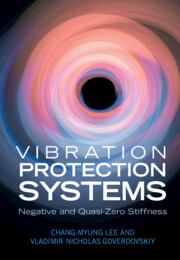Book contents
- Vibration Protection Systems
- Vibration Protection Systems
- Copyright page
- Contents
- Preface
- Acknowledgments
- Glossary
- 1 Vibrations Destroying Human–Machine Systems Inside and Outside
- 2 Vibration Protection Systems with Negative and Quasi-Zero Stiffness
- 3 Modeling of Elastic Postbuckling in Large and Dimensioning the Mechanisms with Negative Stiffness
- 4 The Type and Number Synthesis of Function-Generating Mechanisms
- 5 Dynamics of Systems with Sign-Changing Stiffness
- 6 Dynamics of Systems with Sign-Changing Stiffness
- 7 Dynamics of Systems with Sign-Changing Stiffness
- 8 Methods of Experimental Study of Vibration Protection Systems with Negative and Quasi-Zero Stiffness
- 9 In Harmony with Conventional Vibration Protection Systems
- 10 Development and Use of Vibration Protection Systems with Negative and Quasi-Zero Stiffness
- Index
- References
3 - Modeling of Elastic Postbuckling in Large and Dimensioning the Mechanisms with Negative Stiffness
Published online by Cambridge University Press: 29 October 2021
- Vibration Protection Systems
- Vibration Protection Systems
- Copyright page
- Contents
- Preface
- Acknowledgments
- Glossary
- 1 Vibrations Destroying Human–Machine Systems Inside and Outside
- 2 Vibration Protection Systems with Negative and Quasi-Zero Stiffness
- 3 Modeling of Elastic Postbuckling in Large and Dimensioning the Mechanisms with Negative Stiffness
- 4 The Type and Number Synthesis of Function-Generating Mechanisms
- 5 Dynamics of Systems with Sign-Changing Stiffness
- 6 Dynamics of Systems with Sign-Changing Stiffness
- 7 Dynamics of Systems with Sign-Changing Stiffness
- 8 Methods of Experimental Study of Vibration Protection Systems with Negative and Quasi-Zero Stiffness
- 9 In Harmony with Conventional Vibration Protection Systems
- 10 Development and Use of Vibration Protection Systems with Negative and Quasi-Zero Stiffness
- Index
- References
Summary
Designing and finding a reasonable trade-off between dimensions and performance of structures and mechanisms with parametric elements of negative stiffness in large is a fundamental problem in development and practical use of infra-low-frequency vibration protection systems for humans and engineering. A method is proposed and formulated for modeling the stress-strain under nonlinear postbuckling of the structures and for an optimal dimensioning of the mechanisms. The method is based on the hypotheses and statements of consistent theory of thin shells and includes (a) basic design theory, (b) validation of prediction that parametric elements are to be thin-walled structures to provide viability of the mechanisms and harmony with a vibration protection system, (c) algorithm for modeling geometrically nonlinear deforming the structures and iterative procedure that enables an optimal computable scheme for designing the mechanisms by the FEM, and (d) fundamental relationships between design parameters in terms of compactness and compatibility of the mechanisms with workspace of the systems and for extension the range of stiffness control, where system natural frequencies can be reduced until nearly-zero values. A lineup of geometrically similar mechanisms with negative stiffness in large has been designed for seat suspensions, mountings, and platforms.
- Type
- Chapter
- Information
- Vibration Protection SystemsNegative and Quasi-Zero Stiffness, pp. 52 - 84Publisher: Cambridge University PressPrint publication year: 2021

